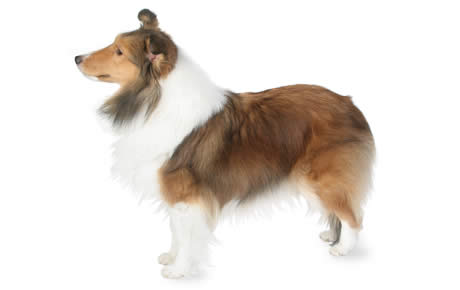Line brushing your Sheltie is a basic method that lets you groom your dog’s hair through to the skin, in sections, layer by layer. Start at the back of the head and top of the neck and separate your pet’s hair in a line, down to the skin. Brush the coat well, then move down the neck, divide off another section of hair, and brush through that. Continue in this manner until you have groomed down the neck and down the side of the body, brushed the hip and thigh, and ended at the croup.
Many groomers prefer to brush the hair on the neck and body against the direction of hair growth, a technique called back brushing, when they line brush. Others brush first in the direction of hair growth, removing as much dead hair as possible, and then back brush. The technique you choose to groom your Sheltie will depend on the amount of coat he has and its condition.
Spraying the coat lightly with water as you line brush can help make it easier for the brush to glide. There are also light spray “leave-in” conditioners and de-tangling solutions available that can be used for this purpose.
The back of the thigh has dense, long hair (called the “pants” or “skirts”). This hair should be brushed out carefully to separate all of the hair without injuring the delicate skin on the back of the thighs. Brush out the tail completely, working from the base of the tail and separating the hairs all the way to the tip of the tail.
Brush the front legs, paying special attention to the axillary (armpit) area, where hair tends to tangle and mat. Brush out the long hair on the back of the front legs, all the way down the pasterns to the feet. Brush out the hair on the rear legs from the hock down. A flea comb is handy to remove fine, dead hair on the hocks and pasterns.
When a Sheltie has not been groomed regularly, knots and mats can form at the base of the ears, in the axillary area, in the groin or inner thigh, and around the base of the scrotum. Hair may also tend to mat under the tail, near the anus or vulva. Tangles or mats in these delicate areas should be removed gently and very carefully with a hair de-tangling product. If mats are too thick to remove with a brush or comb, the mats can be cut or gently teased out with blunt-tipped scissors, taking great care not to accidentally cut the skin.
Helpful Tip: If your Sheltie’s coat needs a lot of grooming, you may choose to split grooming into two or three sessions so you and your Sheltie don’t become too tired or bored with the project. Grooming should be fun for both of you. Stop grooming while your Sheltie is still happy and enjoying all of the attention you are lavishing on him so you can end the session on a positive note!
Grooming the Head
Check your Sheltie’s eyes, ears, nose, and mouth. Clean the ears gently, if needed. Brush the hair on the side of the face. You can also smooth the hair on the sides of the face with a stripping stone. Gently comb the hair on and around the ears with a fine-toothed comb, such as a flea comb. With blunt-tipped scissors, trim straggling hairs on the back of the ear and around the ear tip. Check the fine hairs on the outer sides of the base of the ears.
These hairs are more prone to tangle and form small knots. If they are not kept combed out regularly, they can form mats. If your Sheltie’s hair is tangled, use a gentle de-tangling solution or spray developed for dogs. Wet the hair, and then gently comb out the tangles. Trim away excess hair in front of the ear, so that it does not extend more than half-way up the inside of the ear.
Puppy ears. Sheltie ears are supposed to naturally tip over at the top. Naturally tipping ears is an inherited trait. When Shelties are very young puppies, their ears may tip, but about the time their teeth are coming in, some puppies’ ears may start to stand up straight, giving them a foxy appearance. This is called “prick” or “erect” ears.
Breeders often tape, brace, or weight a Sheltie puppy’s ears to train the ears to tip if they do not tip naturally. There are many different “ear training” techniques, some more successful than others. If your Sheltie’s ears start to rise and you do not want them to remain erect, contact the breeder for advice.

